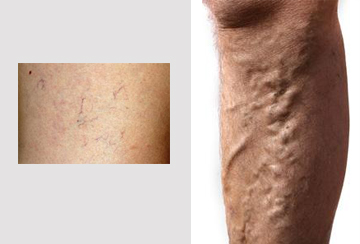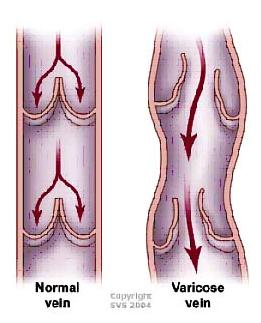Our Washington University vein specialists treat vein problems in different ways depending on their severity. You can get an understanding of your treatment options by identifying which type of vein problems you have. Look at the pictures below to identify your vein problems. After you have read through this section, be sure to click on both the Evaluation and Treatment portions of the website to learn about how our doctors would treat your vein problems.

What do veins do and how do they work?
You have three kinds of veins in your legs:
- the superficial veins, which lie closest to your skin, and which give rise to varicose veins and spider veins,
- the deep veins, which are located in the center of the leg, and
- the perforating veins, which connect the superficial veins to the deep veins.

The function of the leg veins is to return the bluish, oxygen-poor blood to the heart. When you are in the upright position, the blood in your leg veins must work against gravity to return to your heart. To accomplish this, your leg muscles squeeze the deep veins of your legs and feet. One-way flaps, called valves, in your veins keep blood flowing in the right direction. When your leg muscles contract, the valves inside your veins open. When your legs relax, the valves close. This prevents blood from flowing in reverse, back down the legs.
When you walk and your leg muscles squeeze, the venous pump mechanism works well. But when you sit or stand, especially for a long time, the blood in your leg veins can pool and the pressure in your veins can increase. Deep veins and perforating veins are usually able to withstand these increased pressures. However, if you are susceptible, your superficial veins can become dilated as a result of this pressure. This stretching can weaken the walls of your veins and damage your vein valves. Damaged valves allow venous blood to cascade back down towards the foot, a process known as venous reflux. Venous reflux causes high blood pressure inside your superficial leg veins.
Spider Veins
Spider veins are tiny but engorged veins under the surface of the skin. They look like a nest of fine blue or red lines just under your skin. Spider veins are not usually a serious medical problem, but they can be a cosmetic concern, and they can cause symptoms of aching or burning pain, or itching. Most people will develop spider veins as they age, and these spider veins are often more prominent for women. Spider veins are progressive, and new spider veins will continue to occur over time. Very rarely, spider veins can bleed. Despite their tiny size, the amount of bleeding that can occur with a spider vein can be substantial.
Varicose Veins
Varicose veins are enlarged superficial veins that afflict millions of Americans. Both men and women can develop varicose veins. Varicose veins can occur in any age group, starting in adolescence. Pregnancy, weight gain, long periods of standing, and a family history of varicose veins are all risk factors for this disease. Varicosities become distended and bulging in the sitting or standing position, and often have a twisting, coiled appearance. Varicose veins can cause aching, ankle swelling, night cramps or feelings of leg fatigue or heaviness after prolonged periods of standing. If left untreated, they can progress to cause skin damage including darkening of the skin or even ulcers. Varicose vein symptoms typically worsen over time.
What are the Symptoms of Varicose Veins?
Some patients with varicose veins claim to have no symptoms. Usually, this is because varicose vein problems come on slowly over many years and patients simply become used to them. Many people with varicose veins notice that their legs may be heavy, tired, restless or achy. Standing or sitting for too long may worsen their symptoms. They may notice significant swelling in the ankle area by the end of the day. Some patients may also experience night cramps. Most patients also notice varicose veins protruding above the surface of the skin. Less often, the skin on the lower part of the legs may darken, become irritated, or form sores. Even if the sores heal, they tend to heal slowly and to recur unless the underlying vein problem is treated.
Occasionally, the stagnant blood in these large surface varicose veins can clot; this is called superficial phlebitis. If you have varicose veins, you may also have an increased chance of developing deep vein thrombosis (DVT). DVT may cause sudden, severe leg swelling. DVT is a serious condition that requires immediate medical attention.
Information adapted from, and illustrations used with permission of, the Society for Vascular Surgery.